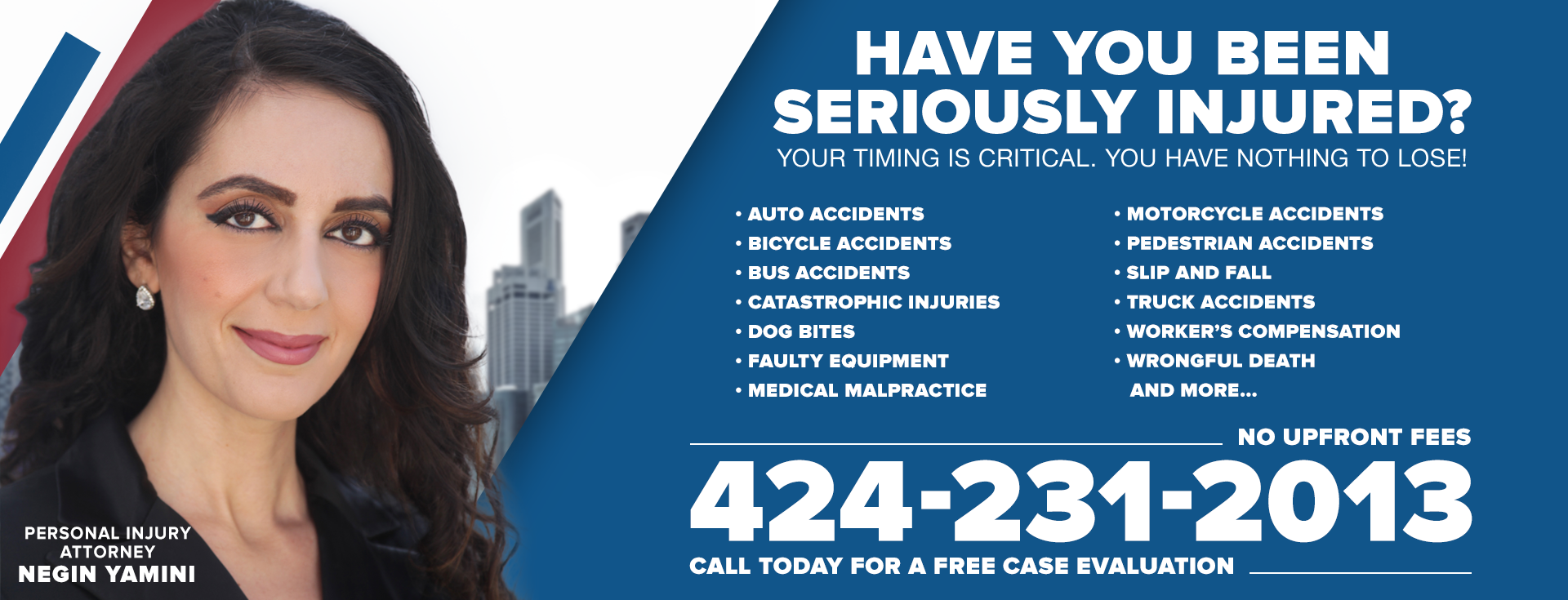The language of California personal injury law is more complex than you might think. While negligence and malpractice are often confused, they have specific legal definitions that can significantly impact your case. Although both involve a failure to act with reasonable care, the key difference is that general negligence focuses on the person’s conduct, the standard of care they failed to meet, and the standard of care to which he/she was supposed to be held. This is a crucial distinction to understand when pursuing justice over an injury.
If a careless driver or medical professional injures you, understanding the peculiarities of general and professional negligence in California will help you overcome the legal barriers and receive the payment you are entitled to.
What is Negligence?
General negligence is the basis of most personal injury cases in California. In its simplest form, negligence is the lack of reasonable care to avoid injury to others. It is engaging in an act (or a failure to do an act) in a way a reasonable person would not, resulting in injury, damage, or loss. To effectively establish a claim of general negligence, you must prove four main elements:
-
Duty of Care
A duty of care implies that the defendant (the sued person or company) was legally bound to exercise some degree of care over the plaintiff (the injured party). For example:
- A driver must drive safely
- A grocery store must provide a safe environment for its customers
-
Breach of Duty
Breach of duty happens when the defendant does not exercise the duty of care. This is usually compared to the reasonable person's standard, which is what a hypothetical, ordinarily prudent person would have done under similar circumstances. For example:
- When a driver disobeys a red light, he/she has violated the duty to drive safely
- When a grocery store allows a spill to go hours without cleaning, they have failed its duty of having a safe store
-
Causation
Causation requires a direct connection between the defendant's breach of duty and the plaintiff's injuries. This includes two components:
- ‘But-for’ causation — The injury would not have occurred without the defendant’s actions
- Proximate causation (the injury was a foreseeable result of those actions).
-
Damages
Damages are the real damage or loss to the plaintiff caused by negligence. Examples of damages include medical costs, lost income, pain and suffering, and other measurable damages. A negligence claim cannot exist without actual damages.
For example, you are in a grocery store, and a spill in one of the aisles has been there for a long time. The store had a responsibility to keep the aisles safe. By failing to clean the spill, they violated that duty. As a result, you slipped and broke your arm. The negligence on the part of the store to clean the spill resulted directly in a broken arm. The result is medical bills and pain and suffering (damages).
What is Professional Malpractice?
While general negligence applies broadly, professional malpractice is a specific negligence that a licensed professional commits. It arises when a professional does not exercise the specialized standard of care expected by his/her profession, thus causing injury to a client or patient. This is a critical distinction from general negligence, which is assessed based on what a reasonable person would do. Professional malpractice is measured against what a similarly qualified professional in the same community would do under similar circumstances.
At the heart of professional malpractice is the specialized standard of care. Those of a similarly trained professional do not judge the actions of an average person, but by what a reasonable and prudent member of that particular profession would have done. For doctors, it points to the medical practices and procedures that similarly trained professionals would follow. In the case of lawyers, it is the legal and ethical norms that a good lawyer would observe.
A typical instance of professional malpractice is medical malpractice. It occurs when a medical professional, including a doctor, nurse, surgeon, or hospital, acts carelessly, leading to a patient's injury or death. For example, a case where a surgeon commits a preventable mistake during surgery, which causes additional problems for a patient, is a case of medical malpractice. This is not merely a minor error but a departure from the accepted standard of care that another reasonably skilled surgeon would have followed.
Another example is misdiagnosis, where a doctor fails to identify a serious condition that a competent doctor would have recognized, causing a delay in the treatment and making the patient even worse. This could amount to medical malpractice. The key difference lies in the professional’s specialized knowledge, training, and ethical obligations, which set a higher standard of care than that applied to the public.
Main Differences in Negligence vs. Malpractice
Knowing the differences between general negligence and professional malpractice laws in a personal injury claim context is important. Although both involve a breach of duty resulting in harm, the nature of the duty, the parties involved, and how the breach is proven differ significantly, affecting the legal process.
Who Can Be Sued?
One of the key differences is who can be sued. Regarding general negligence, practically any person, organization, or company can be sued and subsequently found guilty.
This broad applicability means that if an individual fails to exercise ordinary care, be it a driver on the road or a property owner, and harm results, they can be sued for general negligence. The range of possible defendants is broad and includes various daily interactions and situations requiring a standard of care.
In contrast, professional malpractice suits are limited to only licensed professionals in their particular industry. This includes professionals like doctors, lawyers, dentists, architects, and financial advisors. The lawsuit directly addresses a failure in the professional capacity of the individuals, so the potential defendants are much narrower and highly specialized.
Legal Duty and Standard of Care
This difference in who can be sued reflects a corresponding difference in legal duty. In the case of general negligence, the test is always the same: a person is supposed to behave as a reasonably prudent person would in the same situation. This objective, common-sense standard evaluates whether the behavior was less careful than what an ordinary person would consider reasonable. It is a standard easily understood by a jury, reflecting the social expectations of prudent behavior in general.
In contrast, professional malpractice applies a higher, profession-specific standard of care. This implies that the professional is bound to exercise the same competence, skill, and diligence that a reasonably skilled professional in the same field and community would be expected to exercise under similar circumstances. This standard is much more specific and requires that a professional stick to the accepted practices, ethical standards, and specialized expertise that may be unique to that profession.
Proving a Breach of Duty
Because the duty in malpractice cases is highly specialized, how it is established differs significantly. In general negligence cases, a breach may often be proved by relying on common knowledge and general evidence. Witnesses, accident reports, or logical inferences are usually sufficient to establish a violation of the general standard of care.
Based on their own experiences, the jury can usually decide whether a defendant was reasonable. However, professional malpractice is nearly always proven only by the test of an expert in the same profession. The expert explains the complex professional standards of care to the court and jury and how the defendant failed to meet these established standards of care. A lay jury without this special insight would rarely be able to comprehend or decide whether there was malpractice, which is why expert testimony is crucial in these cases.
Complexity and Expense of Litigation
The nature of these differences directly transfers to the complexity and expense of litigation. Ordinary negligence cases are generally easier to pursue. The evidentiary standards are usually lower and rely on facts accessible to ordinary people. There is no strict need for costly expert witnesses, reducing legal expenses and making these cases more affordable.
However, professional malpractice cases are far more complex and costly to litigate. Hiring specialized expert witnesses, who charge high fees for analysis, reports, and courtroom testimony, significantly increases litigation costs. Moreover, deciphering professional standards, technical language, and expert arguments adds significant complexity, requiring more legal resources and time.
Additional Professional Malpractice in California
While medical malpractice is the most widely recognized form of professional negligence, the definition of professional malpractice is much broader than the medical field. Any professional licensed to practice can be sued under malpractice when he/she fail to adhere to his/her standard of care, which leads to a client's injury. This broader view reflects the significant trust placed in professionals and the serious consequences when that trust is breached.
-
Legal Malpractice
Other professions also have similar weighty responsibilities, and breach of these responsibilities may result in different kinds of malpractice. For example, legal malpractice occurs when an attorney's negligence harms his/her client. This may be in several forms, including missing critical court deadlines, resulting in case dismissal, or failing to detect and address a conflict of interest that compromises the client’s legal position. It may also involve inadequate legal research or incorrect legal advice with devastating financial or legal consequences for the client, which can negatively impact the outcome of the client’s legal matter.
-
Accounting Malpractice
Likewise, financial experts are capable of committing accounting malpractice. This is usually the carelessness of an accountant or an auditor that causes a financial loss to a client or a business. These instances can be negligent tax advice that leads to substantial penalties, errors in preparing inaccurate financial statements that falsely portray the company as financially healthy, or failure to identify fraud during an audit. These mistakes can have severe financial consequences, ranging from IRS penalties to serious business losses due to their trust in their financial know-how and precision.
-
Dental Malpractice
Dental malpractice is another form of professional negligence beyond general medicine. This may occur due to the inability of a dentist to follow the standard of care, which results in a patient's injury. Common examples include nerve damage during root canals, removal of a healthy tooth instead of the damaged one, or poorly placed bridges or crowns that cause ongoing pain and difficulty chewing or speaking.
-
Architectural Negligence
In addition to physical injury, there are instances of architectural negligence, where architects or engineers fail to exercise due diligence in their designs, resulting in structural defects or other problems that result in property damage or create hazards for building occupants.
-
Therapist Malpractice
Even therapists may be liable for malpractice when their actions or omissions do not meet the professional standard of care and the patient is injured, especially in confidentiality breaches or violations of therapeutic boundaries.
Do I Have a Case? Establishing Your Claim
Proving a successful medical or professional malpractice claim requires meeting stricter legal standards than those for general negligence claims. Proving a breach often requires highly specialized evidence and expertise because of the high standard of care expected from professionals.
One of the most critical requirements is expert testimony. Unlike general negligence cases, which everyone could understand, malpractice cases in California almost always require expert testimony. This specialist, who is usually a professionally trained and experienced individual in the same line of work as the defendant, is essential in two main ways:
- To define the applicable professional standard of care
- Explain precisely how the defendant’s actions or omissions failed to meet it
A malpractice claim is unlikely to survive early legal challenges without a credible expert to explain the complex standards and the deviation, and expert testimony is essential in most malpractice cases.
In addition to proving the facts of a case, one of the most critical considerations of bringing a malpractice claim is the legal deadlines, or the statute of limitations. It is one of the most urgent and critical issues for any prospective plaintiff.
In California, medical malpractice claims are generally subject to a one-year statute of limitations that begins to run when the injured party knows, or with reasonable diligence should have known, of the injury, or three years from the date of the alleged malpractice, whichever comes first. There are limited exceptions, for example, cases involving minor plaintiffs or cases of fraudulent concealment. Failing to meet these deadlines will almost certainly result in permanent dismissal of the case, regardless of its merits. Thus, it is crucial to learn and strictly follow these statutory time limits to maintain the right to demand compensation.
The Medical Injury Compensation Reform Act (MICRA) significantly shapes California's legal framework for medical malpractice. Enacted in 1975, MICRA was intended to reduce what was considered excessive litigation and increase malpractice insurance rates for health care providers. One key provision of MICRA is its cap on non-economic damages, which historically limited compensation for subjective harms, including pain, suffering, emotional distress, and loss of consortium, at $250,000. This cap was substantially revised by the Assembly Bill 35, which became effective on January 1, 2023. The limitation on non-economic damages in cases that involve malpractice as the cause of injury was initially raised to $350,000 and will increase by $40,000 annually until it reaches $750,000 in 2034. In the case of wrongful death, the cap was raised to $500,000 and will increase by $50,000 annually until it reaches $1 million in 2034.
While these changes allow for greater recovery in malpractice cases, they still impose substantial limitations compared to other personal injury claims. They are an important consideration in determining the possible value of a malpractice claim.
Steps to Take in Case You Suspect Negligence or Malpractice
When you suspect negligence or professional malpractice on behalf of a loved one or yourself, take action as soon as possible and carefully to preserve your health, rights, and any potential legal claim. Being proactive and orderly will go a long way in determining the success of your predicament.
-
Document Everything
This is the most essential first step. The best way to start is to carefully collect all the available medical records, including diagnostic tests, treatment plans, prescriptions, and billing statements. Also, maintain a comprehensive record of the symptoms you experience, levels of pain, emotional suffering, and how the injury has affected your daily routine and working life.
Take photos of any visible wounds or other complications. These documents will be critical in proving your case and justifying your damages claims.
-
Seek an Expert’s Opinion
Have a second opinion from another expert in the same profession as the person or organization you suspect of negligence. This objective evaluation can verify that the standard of care was violated and give alternative treatment possibilities. This evaluation not only assists you in your immediate recovery but also gives you a professional opinion that can support your legal suspicions, which can significantly benefit you in determining the appropriateness of the treatment you received.
-
Be Cautious with Communications
Importantly, do not sign any waivers or talk at length with the insurance company or legal representatives of the professional without first consulting your attorney. Insurers are primarily interested in defending their policyholder and paying out as little as possible. Everything you say, or any documents you sign, may be used against you, jeopardizing your chances of receiving full and fair compensation for your injuries. You should never make any communication on your own, especially with your legal counsel.
-
Understand Time Limits (Statute of Limitations)
Moreover, learn about the critical time limits to file. As mentioned above, California law provides strict deadlines to bring a malpractice claim, which would generally be one year from learning of the injury or three years from the date of the injury, whichever comes first.
These are strict deadlines, and failure to meet them will most likely lead to losing the right to sue, no matter how solid your claim is. Time is not on your side, and procrastination can be lethal to your claim.
Find a Personal Injury Attorney Near Me
Understanding the differences between general negligence and professional malpractice in California is important when pursuing justice following personal injury. Although both entail a breach of duty, the who, what, and how of proving your case differ and can considerably affect the legal process. Knowing these differences is your first step, based on the standard of care, the need for expert testimony, and its costs.
Do not hesitate to contact the Los Angeles Personal Injury Attorney if you suspect you or a loved one is a medical negligence or professional malpractice victim. Time matters, and deadlines are stringent and may cost you your claim. Call our skilled personal injury or malpractice lawyers today at 424-231-2013 for a free consultation.
























